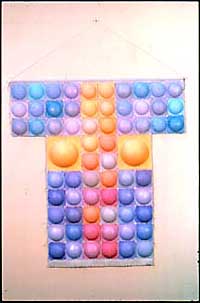On April 19, 2012, Nancy Heller, Professor of Modern & Contemporary Art History at The University of the Arts in Philadelphia, spoke at Towson University about the life and art of a Baltimore icon, Amalie Rothschild.
Amalie Rothschild (1916-2001) produced over 1500 works and has been exhibited at the Baltimore Museum of Art and the Walters Art Museum as well as in 5 states and foreign countries. She received, among other awards, the Maryland Lifetime Achievement Award. She started to draw from the time she was six years old; she spent at least six hours a day in her studio, even when she was in her 80s. Currently Towson University is featuring a retrospective show of her work in which “all her media is expressed.”Amalie was described as articulate and intelligent in paint and in person. She was a passionate art and “arts-rights” advocate and went to every art opening for every Baltimore artist everywhere. She knew how important it is for people to show up to support art events. In all her work, she was constantly experimenting with various media and techniques. Her art and voice should not be forgotten.
Nancy Heller, author of the book “Amalie Rothschild,” discussed highlights of Amalie’s artistic work and career. Heller said she chose the title of her speech – “Quiet Feminist” – because Amalie was not strident. She had a sense of humor. Once a visiting official from Russia, after viewing her work, criticized it; Amalie retorted that politicians are not good critics of art. And she deeply cared about both her family and her art. Amalie was immensely curious and her work ranged from sculpture, jewelry, paintings, drawings, printmaking, handmade cast paper, gold leaf, and textiles like murals, glass windows, and hooked rugs. She lived in a time when women put the interests of their parents, husband and children ahead of their own. Fortunately, her husband supported her efforts at art. Heller informed the audience that Amalie had many opportunities – for example to study in Paris and to exhibit in New York – but her family obligations kept her close to Baltimore.
Heller informed the audience that after World War II Amalie Rothschild started teaching art around the Baltimore area. Amalie was an art therapist at the Sykesville mental hospital. Amalie traveled extensively around the world and her experiences are reflected in her work. She was especially influenced by Egyptian art and objects. She loved working with power tools and was quite a successful craftsman who set up a well-stocked studio.
Heller showed the audience a photo of a marquee announcing an early show of Amalie’s which read – ironically – “One Man Show.” Heller read to the audience a 1948 article which referred to Amalie (who would have been 32 years old) as a “girl” and condescendingly made it out to be a major accomplishment to do art and be a mother and take care of her house and family all at the same time. Heller said Amalie’s obstacles to her art career would not have been so evident if she had been a man. However, the audience was not enlightened as to how Amalie Rothschild herself reacted to these events. We know that Amalie never had to work full-time, she was able to take private art lessons, and had household help. She was fortunate that her husband, an attorney whose family owned Sun Life Insurance Company, was successful enough that she didn’t have to worry about providing an income for her family. She had the freedom and opportunity to invest time into her art and advocate for artists.
Some of Amalie’s most successful work, said Heller, are her hard-edged geometric sculptural pieces and ironwork that resemble the human body. She adapted famous paintings to her own uses; for example she made whimsical pieces resembling Matisse’s “Pink Nude.” Some of her most interesting works are her sculptures of gold leaf on particle board and her kimono-shaped constructions of concave cast paper “bowls” or yellow, blue, and red plexiglass panes. Several of her self-portrait paintings currently on exhibit at Towson University depict vivid colors, her characteristic red hair, and her intriguing propensity to intersect the figure with strong geometric lines. Her sense of playfulness is evident in the collection. She is quoted as saying “the joy is in the playing.”
The show “Amalie Rothschild: A Retrospective View” is on display at the Center for the Arts Gallery at Towson University through June 16, 2012.

